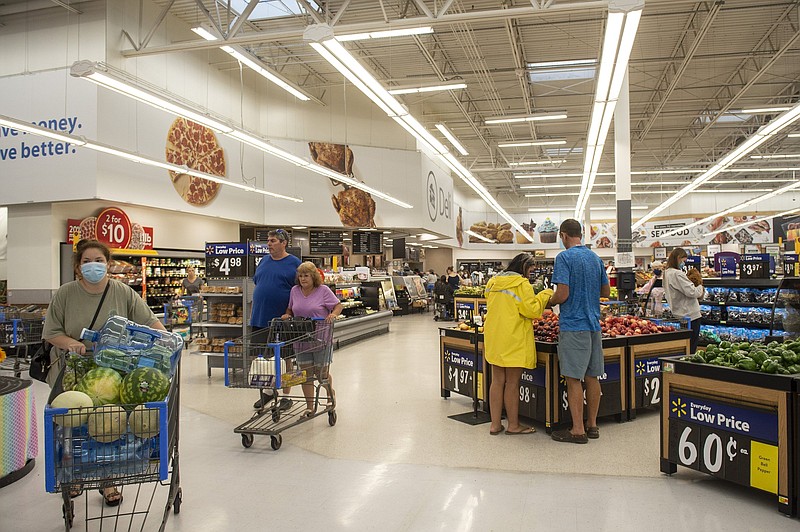Despite a largely re-opened U.S. economy, Walmart Inc. and other grocery retailers continue to face shortages of everyday items as the pandemic-hit supply chain struggles to recover.
From big-box stores to small grocery chains, sellers of food, consumables and general merchandise are finding it hard to offer customers the full selection of products and name brands they're accustomed to buying.
The problem doesn't lie with just one particular point on the supply chain, such as manufacturing, sourcing or imports, industry experts say. Instead, every single point along the supply chain is stressed, with a ripple effect that culminates in stores where shoppers can't find their favorite brand of peanut butter, soft drinks or cat food.
Unlike the panic-induced buying seen early in the pandemic, shoppers' buying patterns have remained steady -- though heightened -- since March 2020, according to a spokeswoman with FMI, the food industry association formerly known as the Food Marketing Institute.
"From a big-picture perspective, the current challenges are due to a confluence of supply chain factors," FMI spokeswoman Heather Garlich said. These include materials and ingredients; labor; equipment; transportation and trucking; capacity; inventory control; cost pressures; and weather-related events, she said.
But of all these challenges, it's the national labor shortage that's put the kinks in the supply chain, said Doug Baker, FMI's vice president of industry relations.
As an example, Baker said, "You're in the trucking industry, and you need to get parts for trucks, but they can't get the part because it's on a ship in a port and there's not enough labor to unload the ship. It's a ripple effect and it backs up everything down the line."
"And this will go on until the labor shortage is fixed," Baker said. "We've got to get our businesses fully employed again."
Although Walmart didn't immediately respond to requests for comment about its out-of-stock items and brands, company executives have repeatedly addressed the issue in interviews and presentations over the past year.
Walmart Chief Financial Officer Brett Biggs told investors last month that "out-of-stocks in certain general merchandise categories are running above normal, given strong sales and supply constraints."
"We continue to monitor industry trends related to transit and port delays," Biggs said. "Our merchants continue to take steps to mitigate challenges, including adding extra lead time to orders and chartering vessels specifically for Walmart goods."
John Furner, chief executive officer of Walmart U.S., on the same conference call praised the company's supply chain team for its management of the disruptions in the global supply chain. Walmart has secured resources for transporting goods in the third and fourth quarters, he said.
"We feel good about the inventory positioning, particularly compared to last year with inventory up 20% across the segment," Furner said.
Walmart's U.S. supply chain teams "have done a number of things to ensure that flow is strong," Furner said. "That would include everything from offshore to onshore properties like our distribution network and, in particular, our food distribution team has done an amazing job keeping products moving."
Kathryn McLay, chief executive officer of Walmart's Sam's Club division, said in a recent video interview with Yahoo Finance (watch it here: arkansasonline.com/samsceo) that she's confident Sam's Club will have inventory on hand for consumers, especially going into the Christmas holiday shopping season.
"We have been working through supply chain challenges it feels like for the past 18 months, and it has certainly gotten better," McLay said. "We've had to work to pull forward inventory and to make sure that we are prioritizing that the right freight gets here on time."
At the same time, McLay said, Sam's Club is working with its suppliers to keep prices low for members.
Another big-box retailer, members-only warehouse chain Costco, has gone so far as to place purchase limits on certain products -- a strategy seen often in the early months of the pandemic when shoppers' panic-buying and stockpiling of supplies emptied store shelves.
A recent update to Costco's covid-19 policy, posted on its website, states simply, "Some warehouses may have temporary item limits on select items."
The company is staying mum about the policy change, but Costco's online ordering site limits the purchase quantities of some paper goods. For instance, a 12-roll pack of Bounty paper towels was limited to one per customer on Thursday.
Smaller grocery chains are feeling the pinch as much as the big-box stores, said Steve Edwards, special projects manager for GES Inc., which operates eight Edwards Food Giant stores and five Edwards Cash Saver stores.
The pandemic "really spotlighted how fragile our supply chain is," Edwards said, and the problem is mainly labor issues.
"It's not a food shortage or shortage of raw materials," Edwards said. "It's a matter of getting product into stores."
And the products or brands out of stock are constantly changing, he said. "It's kind of like a game of Whac-A-Mole."
Edwards attributes the labor shortage largely to the pandemic.
"Obviously [covid-19] gets thrown in there," Edwards said. The company's main warehouse, in Southaven, Miss., which is already short-staffed, had about 30 or 40 workers out a couple of weeks ago because of the virus, he said.
"It's pushing down on an already constrained labor market," Edwards said. "And I think when you throw in the fact that we're having issues with labor at the store level, and then our warehouse is having issues at the warehouse level, the trucking company's having issues -- you take a little piece out of every step in the process, and you start to see the large impact that it has."
As for when supply chain issues may be resolved, Baker said he's hearing maybe 2022 or 2023. "This will go on until the labor shortage is fixed," he said.
Edwards also said product will begin to flow more smoothly once the labor shortage eases.
"I think it's one of those things that's just going to happen naturally," he said.
